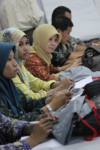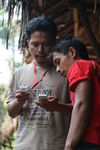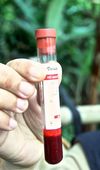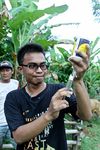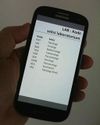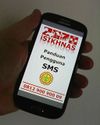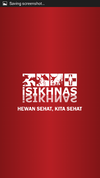ISIKHNAS Training Resources/id: Perbedaan revisi
| Baris 60: | Baris 60: | ||
|Abattoir}} | |Abattoir}} | ||
| − | {{fpblock|Modul 14 : iSIKHNAS Koordinator|Website_dashboard.png|| | + | {{fpblock|Modul 14 : iSIKHNAS Koordinator|Website_dashboard.png| |
| − | Coordinators}} | + | |Coordinators}} |
{{fpblock|Modul 15 : iSIKHNAS WIKI|WIKI LOGO.png|| | {{fpblock|Modul 15 : iSIKHNAS WIKI|WIKI LOGO.png|| | ||
Revisi per 13 Februari 2015 13.15
Daftar isi
- 1 iSIKHNAS Training Centre
- 1.1 Informasi untuk Pelatih dan Koordinator
- 1.2 iSIKHNAS Modul
- 1.3 Modul 1 : Rutin Pelaporan dan Kasus Penyakit Manajemen
- 1.4 Modul 2 : Pelsa : Pelapor Desa
- 1.5 Modul 3 : Penyakit Penting Investigasi dan Respon
- 1.6 Modul 4 : SKKH
- 1.7 Modul 5 : Surveilans actif
- 1.8 Modul 6 : Populasi Hewan
- 1.9 Modul 7 : Vaksinasi
- 1.10 Modul 8 : Instant Messaging untuk iSIKHNAS
- 1.11 Modul 9 : Pendaftaran Pemilik dan ID Hewan
- 1.12 Modul 10 : Manajemen Peternakan
- 1.13 Modul 11 : Kueri sistem
- 1.14 Module 12 : Administration SMS
- 1.15 Module 13 : Rumah Potong
- 1.16 Modul 14 : iSIKHNAS Koordinator
- 1.17 Modul 16 : Menggunakan data dan laporan iSIKHNAS
- 1.18 Modul 17 : Manajemen pelatihan
- 1.19 Module 18 : Spreadsheet uploads
- 1.20 Modul 19 : iSIKHNAS Mobile App
- 1.21 Module 20 : Data laboratorium
- 1.22 Old Material
iSIKHNAS Training Centre
Bagian ini dirancang untuk pelatih dan orang lain yang terlibat dalam mempersiapkan pelatihan bagi staf kesehatan hewan dan hewan di Indonesia untuk membantu mereka dalam menggunakan Sistem Informasi Kesehatan Hewan Nasional, iSIKHNAS.
Training for iSIKHNAS is divided into manageable Training Modules. These modules are designed
- to ensure training is as quick and efficient as possible - most are one day or less,
- to reduce the amount of preparation required by trainers,
- to ensure consistency of materials and approach,
- to be as flexible as possible so that they can be used in response to local needs and priorities,
- to be used for group and individual use, for training and as self-learning units,
- to encourage an ongoing program of staff development.
Informasi untuk Pelatih dan Koordinator
This powerful system comprises a wide variety of functions for a range of different animal health staff so in order to make training more manageable and efficient, these functions have been broken down into short, purpose-specific modules, most of which can be trained in one day and often less.
It is intended that when iSIKHNAS is first introduced into a district ALL veterinary staff involved in day to day animal health services to farmers and their animals be trained by the new district coordinator with assistance from the provincial coordinator and an expert trainer. The first module will always be Module 1 : Routine Disease Reporting and Case Management. This module initiates staff to the important founding principles and philosophy behind iSIKHNAS, introduces the core functionality and reporting mechanisms and allows for more practice and familiarisation with the new service-driven system. This module comprises routine and priority disease reports from the field, treatments, lab submissions, follow up and outcomes - the most common, core tasks undertaken by most staff in district offices. Module 1 is the prerequisite to all other modules intended for this group of technical field staff.
From experience, the first module requires motivated and well-supported trainers with good energy levels, lots of patience and time to allow new users of the system opportunity to practice and gain confidence. It is the module which will determine how well staff adapt to change and embrace the ongoing training of new features in the future. It will set the tone for the other modules which follow. After this first module, district coordinators become solely responsible for developing and undertaking an ongoing training plan for staff. Such a plan should be responsive to the district and provincial priorities, but also to the level of staff motivation and interest and their ability to absorb and adopt new practices. It should be noted that it will be the eventual responsibility of the district coordinator to train all new staff (who are new to iSIKHNAS and new to the district or province) in Module 1 as the need arises. By the time this is necessary there will be many more confident users able to assist in this training task.
Once the basic principles, the first SMS messages and the reflex to use the extensive system queries to help with accurate reporting have been mastered, experience shows that staff pick up and use all subsequent messages very quickly and easily. It is recommended that at least one new module be introduced to staff every month, bearing in mind that not all staff will require the all the tools available so the target audience may differ each time. Not all staff are involved in production and breeding or Abattoir reporting, not all staff will require the Priority Disease Investigation and Response training, and so on. Some modules, such as Village Population Statistics, Vaccination Activities or Active Surveillance (Modules 5, 6 and 7), involve one message each and should come just prior to the planned activities of collecting and recording village animal population data, or a planned vaccination activity as part of a district or provincial program, or a planned sampling activity as part of an active surveillance program.
Some modules are dependent on others and must follow in a logical sequence, Module 9 : Farmer Registration and Animal Identification must precede Module 10 : Breeding Management, for example. Some modules will only be of use and interest to a very small group of system users and so Coordinators may decide to give ad-hoc, one-on-one training in, for example, the use of Instant Messaging (Module 8) or the use of iSIKHNAS data using the website (Module 16). A few modules will be useful to staff with greater administrative responsibility in order to provide the coordinator with greater support in farmer and animal registration, spreadsheet uploads or training management (Module 9, 17 and 18).
For those districts with a network of village-level reporters, Module 2 : Pelsa : Village Reporter module should probably follow quickly after the first module. Staff will be able to assist in the training which often requires higher levels of input and reassurance. A Signs Recognition sub-module can be conducted at the same time to further engage and equip this valuable resource.
As soon as training in a module has taken place, it is imperative that staff commence to use the new tools (sms messages, most often) immediately. It must be adopted by all relevant staff at the same time to ensure excellent compliance from the outset. Coordinators should monitor the system particularly closely during the initial period directly after training has occurred. Staff should never be left to make too many mistakes and become frustrated. Coordinators have monitoring tools at their fingertips which can help to diagnose reporting problems and offer immediate support and advice to staff having difficulties. These should be used to their fullest during this adoption phase.
iSIKHNAS Modul
Old Material
Priority Disease Investigation

